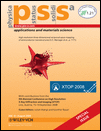Helium implantation into 4H-SiC
Abstract
The paper provides the properties of single crystalline 4H-SiC under helium implantation at temperatures of implantation up to 750 °C and fluences in the range 5 × 1015–1 × 1017 cm−2. The microstructure evolution was studied by transmission electron microscopy cross-section and X-ray diffraction experiments. The mechanical property changes were investigated by using nanoindentation tests followed by atomic force microscopy observations and by using tribological tests. At elevated temperature of implantation and/or in the low fluence regime at room temperature where only the strained state of SiC is obtained, SiC becomes more resistant to crack formation but no significant change in mechanical properties is seen. At room temperature with increasing fluence the damage accumulation leads to the amorphous state for which a strong degradation of the mechanical properties is observed. At elevated temperature of implantation, amorphization is avoided and a thermally activated saturation of the strain is observed in the near surface region whereas defect accumulation occurs near the maximum of damage. Upon annealing subsequent to room temperature implantation, the near surface strain progressively relaxes while the helium ions agglomerate into platelets around the maximum of strain. These platelets evolve into bubble clusters at temperatures where the vacancies become mobile. Under particular conditions of implantation (high fluence and elevated temperature) the swelling of the surface increases during annealing due to the growth of bubbles and the formation of stacking faults resulting from the migration of interstitials towards the maximum of damage.




